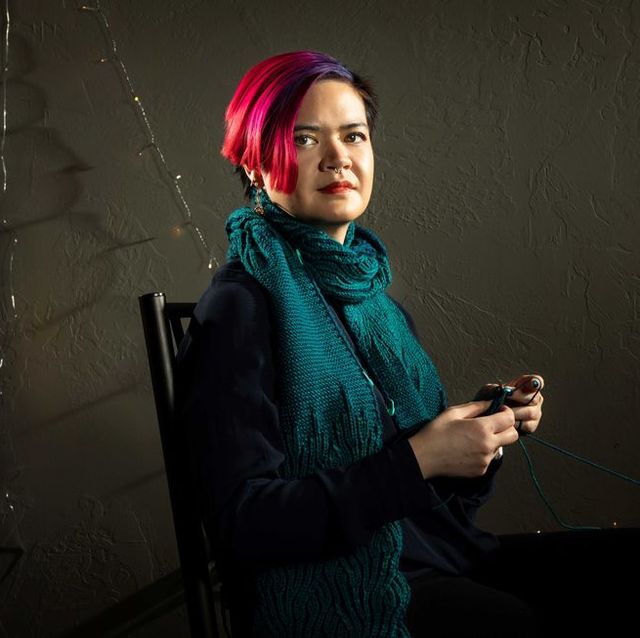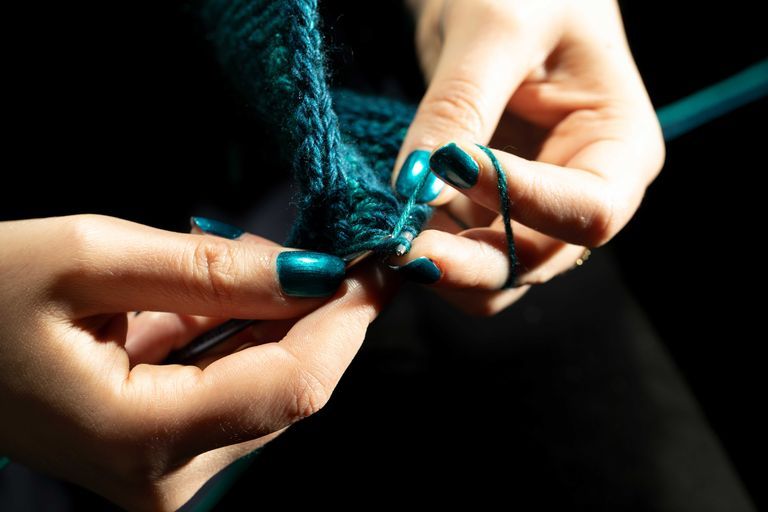The unruly stitch of a dragon first attracted Sabetta Matsumoto to the mathematics of knitting. Unlike the regimented stitches of a sweater that march two-by-two across a textile, the whiskers of this dragon stretched daringly across a lace shawl in a way Matsumoto had never seen before—and she was determined to understand the math behind it.
“I knit really crazy things, and this was the first time that I’d really encountered something that was [so] different,” she says.
Matsumoto, an assistant professor of physics at the Georgia Institute of Technology, studies the limits and possibilities of knitted materials to understand how different stitches transform the mechanical properties—the stretchiness and support—of everyday fabrics.
In her latest project, funded by the National Science Foundation, Matsumoto and her students are searching for a fundamental equation (like those that describe gravity or the flow of water) to perfectly describe the properties of knitted fabrics.
Such an equation could be transformative not only for pure mathematics and the study of theoretical knots, but for applied math in the form of customizable prosthetics, wearable electronics, and new ultra-tough materials. For the astronauts who will one day journey to Mars, for instance, it could mean previously unimaginable spacesuits that protect against the radiation in space.
Knot theory is essential to finding the grand equation of knitting. This type of topology investigates the fundamental traits and limitations of knotted objects. In the case of physical knots, this might take the form of studying how deformations—twists or compressions—affect a fabric’s elasticity, or how far it can be stretched.
In the 1800s, early knot theory focused on the alleged microscopic “knots” of atoms. The physicists and mathematicians behind these concepts had a fairly limited point of reference for such shapes. They looked at large, bulky sailing or farming knots—a more limited form than knots used in textiles, says Karen Daniels, a professor of physics at North Carolina State University who uses knitting in her research.
“Trade knots, like those used in sailing, were typically tied along a single, linear plane—like a rope. But knitted or crocheted knots are more topologically complicated,” she says. Knitting knots and crochet knots need to feed from one knot to the next in a way that won’t unravel and leave a hole in the two-dimensional sheet.
Matsumoto’s research group is interested in how physical qualities, like stiffness and stretch, can be “programmed” into knitted items to control their elasticity and deformable characteristics.
“Knitting has this inbuilt grammar that is quite complex, but I like to think of it as a programmable material: The order of the ‘letters’ or ‘words’ you pick can give you textiles with different mechanical properties,” says Matsumoto.
For example, varying the order of knits or purls in a simple fabric square can create a spectrum of stretchiness and stiffness, like a pair of knitted pants or a swimsuit where different stitch patterns, or “grammars” in Matsumoto’s parlance, can be applied to different areas of the garment for customized stretch or support.
Matsumoto says these grammatical characteristics are related to some of the world’s oldest computers. The Jacquard machine, an 1803 loom attachment, used mechanical punch cards to instruct the loom’s crossing orientations. As computer algorithms transform binary 0’s and 1’s into graphics and calculations, knitters “program” the mechanical properties of fabrics by choosing the order of their stitches. Knits and purls, inverse stitches of one another, are the 0’s and 1’s of knitting.
With a fundamental theorem of knitted materials that can describe any possible stitch, Matsumoto says it would be possible to come up with a universal code to program existing industrial knitting machines to spit out bespoke knitted items.
In the future, such a machine could be used to stitch anything from attachments for customized prosthetics to medical wearables. These completely customizable products would not only take the guesswork out of buying your next blazer or wetsuit off the rack, but could help reduce the economic burden of cookie-cutter fast fashion, says Matsumoto.
Ultimately, she says, there’s no wrong way to design a new knitted material. Just like the dragon that first drew her into the mathematics of knitting, new opportunities for mind-blowing creations and materials are just waiting to be discovered.
Two Essential Tips for Ultra-Tough Knits
You don’t have to wait around for Matsumoto’s high-tech knitting machine to construct heavy-duty, unyielding sweaters, blankets, and socks.
“Our research has [shown] that when you have two stitches of the same type (e.g., knit-knit or purl-purl) next to each other (either laterally or vertically), the fabric will be stiffer than fabric with opposite stitch types next to each other (e.g., knit-purl),” Matsumoto says.
But stiffness also depends on the specific yarn you use. In comparing stockinette, garter, rib, and seed fabrics, Matsumoto found stockinette is the stiffest both laterally and vertically.
—Courtney Linder
🎥 Now Watch This:

Sarah is a science and technology journalist based in Boston interested in how innovation and research intersect with our daily lives. She has written for a number of national publications and covers innovation news at Inverse.
















